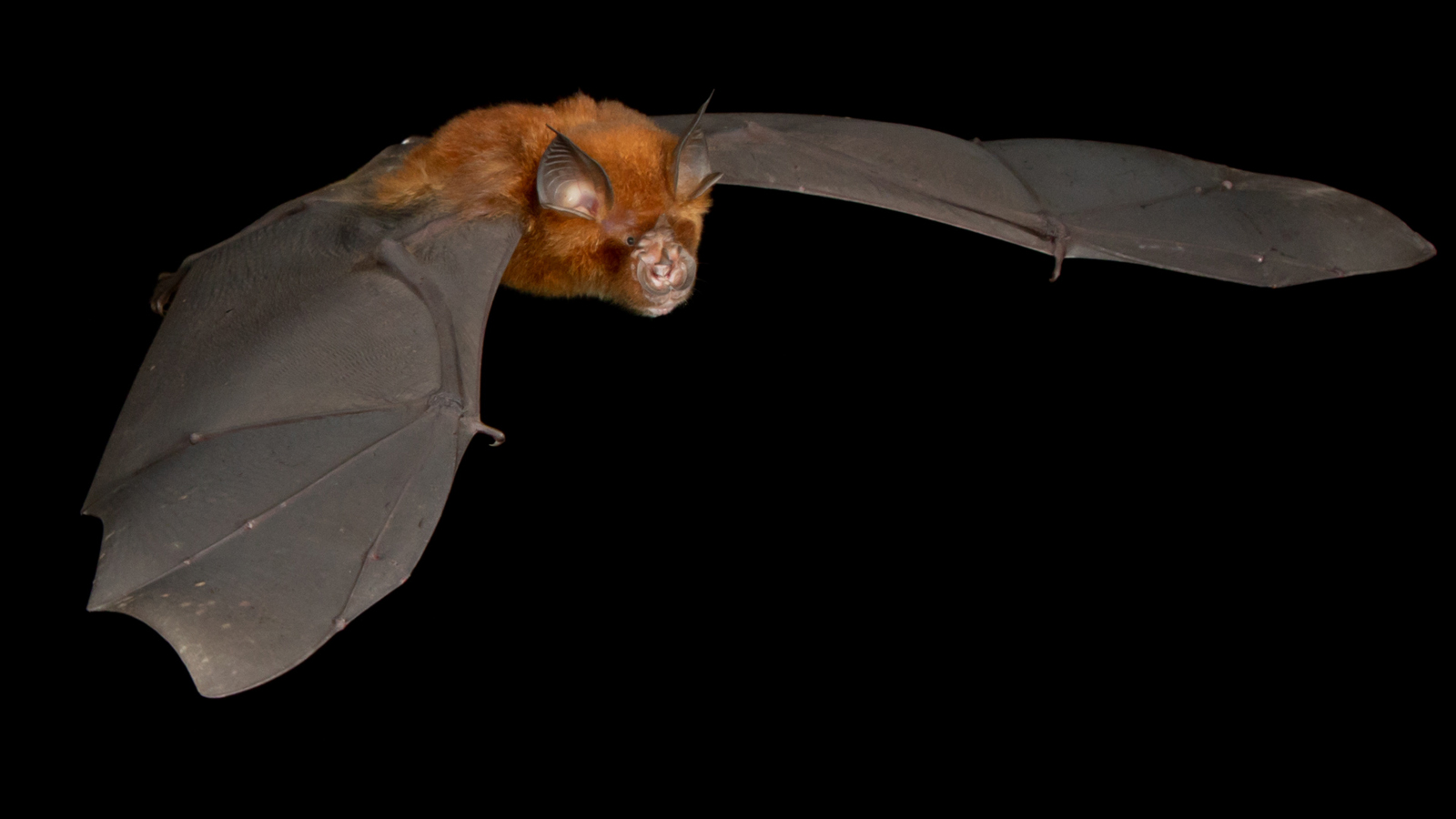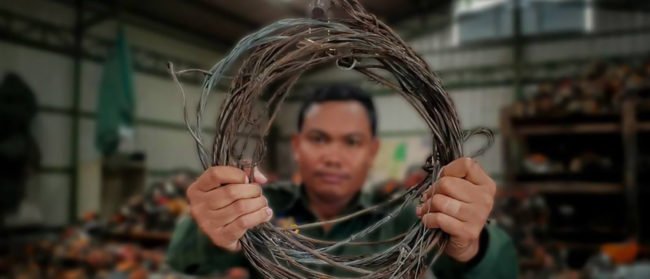Dr. Tigga Kingston is a Professor in the Department of Biological Sciences, Texas Tech University, USA. She is a central figure in the conservation of bats in Southeast Asia and is the founder and director of the Southeast Asian Bat Conservation Research Unit. She is the Co-Chair of the IUCN’s Bat Specialist Group with responsibility for the Old World bats. She earned a PhD degree at Boston University, USA where she studied the community ecology of bat assemblages in Peninsular Malaysia. Tigga and her lab focus on factors shaping bat diversity in unmodified habitats, and the response of assemblages to land-use change and human disturbance in the Old World tropics.
It’s 7.20pm at the edge of the rainforest of Krau Wildlife Reserve in Peninsular Malaysia. Plaintive calls of nightjars herald the transition from day to night as silhouettes of bats flitter in the twilight. It is time to head into the forest.
There are five of us tonight; I’m joined by my two PhD students Juliana Senawi (Julie) and Nurul Ain Elias (Ain) and two assistants, Rahman and Amri, from the nearby Jah Hut indigenous village.
During the day Rahman and Amri have spaced out ten harp traps along the network of forest trails. Harp traps, made up of metal rectangular frames about the size of a vertical window with fishing line stretched across, are set on legs across forest trails.
Bats that forage for insects inside the forest understory often follow trails for part of their journey, and although they have very sophisticated echolocation to find their way around and hunt insects, they have trouble detecting the fine fishing lines. They hit the lines and slide down into a long collecting bag where they can roost and rest before we come and get them.
While bats have earned an unwarranted reputation as spreaders of disease, particularly as a result of the Covid-19 outbreak, we have been studying these forest specialists for over two decades and how human activity is impacting their habitats.
Our research shows that because so many are adapted to forest life and the stable resources it provides, they are unable to adjust to landscapes dominated by agriculture and non-timber plantations like rubber and oil palm. We aren’t the only ones to find this, forest-dwelling bats across Southeast Asia are being lost as humans change the landscape.
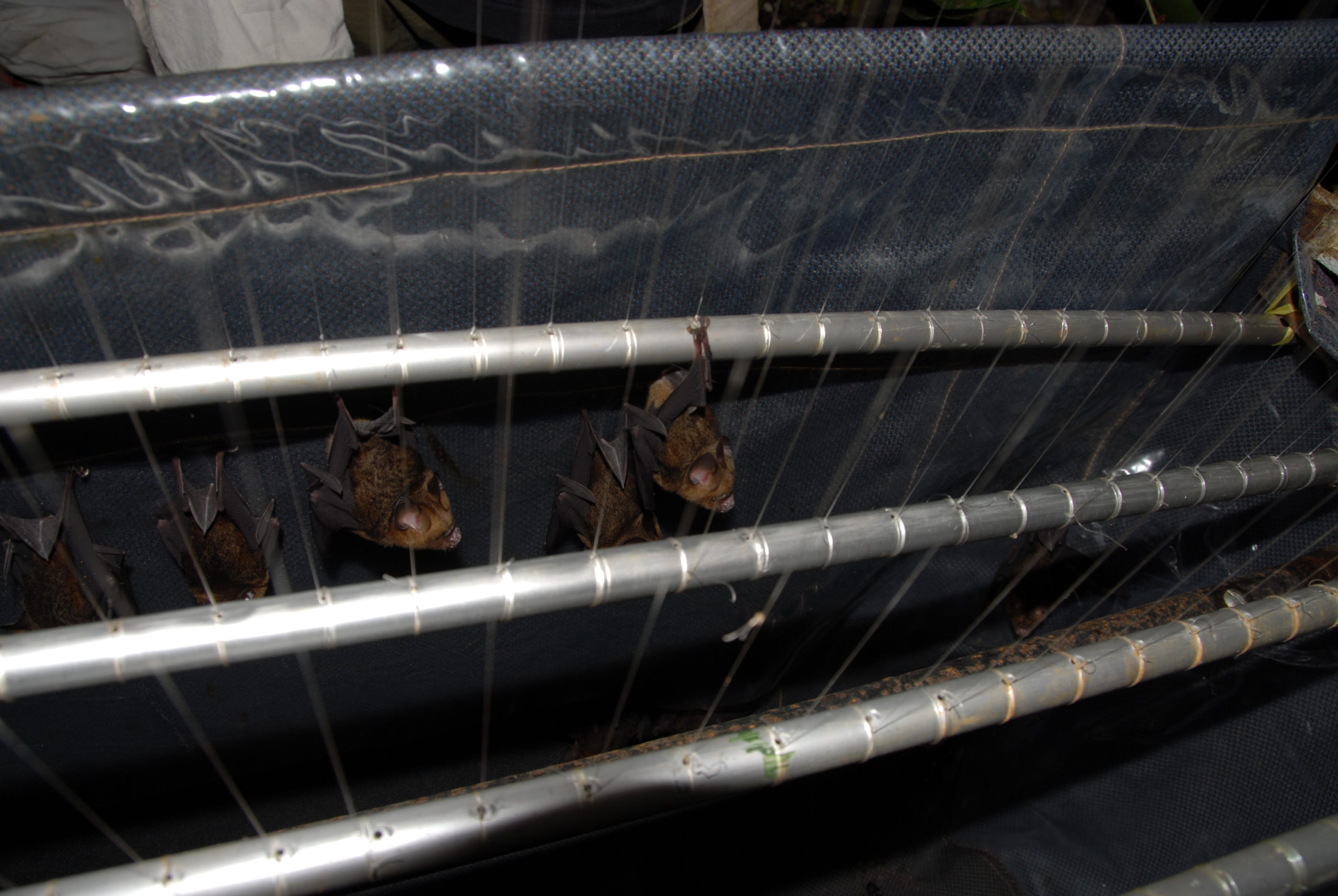
Waiting for pick up! Bats in the collecting bag of a harp trap set across a forest trail. You can see three of the four banks of fishing line and the bats hanging from the banks or side of the bag. Photo: Tigga Kingston CC BY-NC-SA 4.0
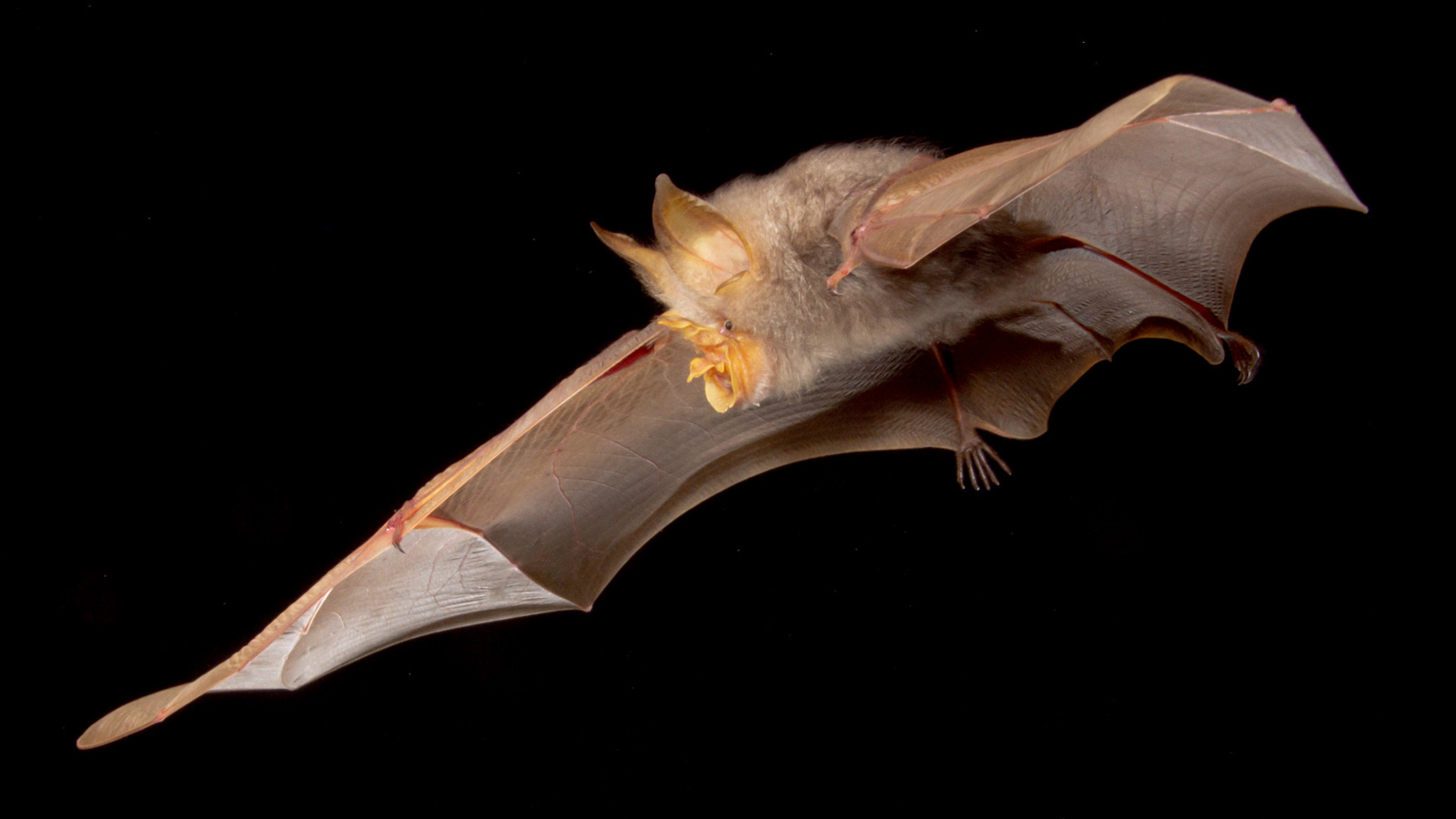
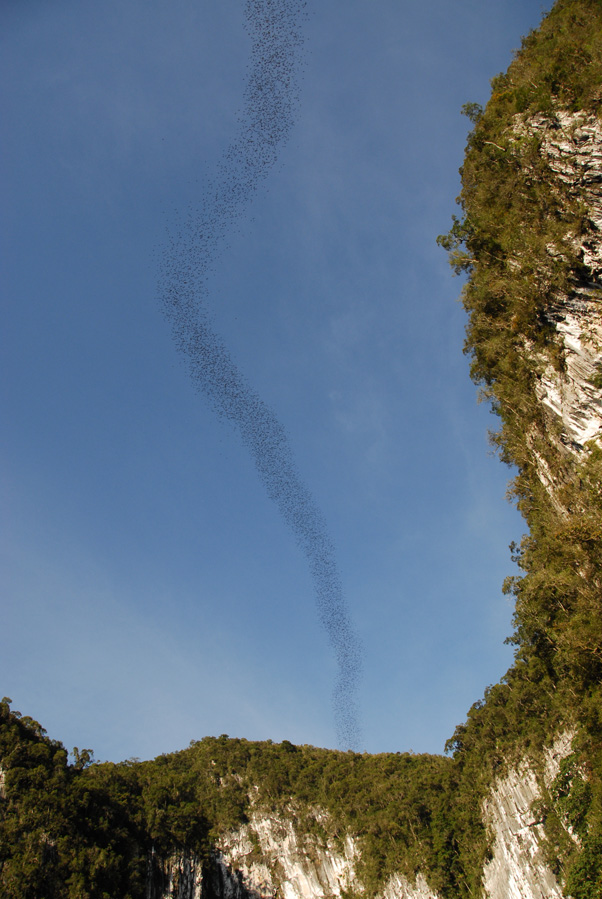
The problem on everyone’s mind right now is of course Covid-19. Bats do not spread Covid-19, you can only catch it from other people. So why all the talk about bats?
The first trap starts us off well. It has two of my favourites – the trefoil horseshoe bat and clear-winged woolly bat. The trefoil horseshoe bat is a very handsome fellow – bats of this species roost on their own under palm or rattan leaves and have tan-coloured wings, long fluffy grey fur, yellow ears, elbows and knees and wonderful yellow noseleaf.
Horseshoe bats blast out their echolocation calls through their nostrils and use their noseleaf, a structure around their nose, to help focus the sound beam as they search for insects.
Julie carefully gets the bat out of the trap. He will be a good candidate for the obstacle course she has devised to see how well different bat species fly through the dense forest of the understory. This helps us understand how different species will respond to changes in forest structure that result in fragmentation and timber extraction.
When Ain goes to get the woolly bat there is a surprise in store – it’s not one bat but three clustered together to make a fluffy ball with the odd foot and wing sticking out! We’ve seen this before – the species lives in small social groups and roosts in clusters of dead leaves or old hanging bird nests.
In the middle of the ball of fluff, noses, feet and wings is a pup, firmly attached to the mother’s nipple. Ain is thrilled, mothers need a lot of energy to produce milk for their pups, so it’s important that they give birth when there are many insects around. We are worried that climate change may alter patterns in insect availability, depriving mothers of food when they need it most, and reducing breeding success.
By the time we have finished checking all 10 traps we have captured 30 bats of 15 species. All told, the rainforest of Krau Wildlife Reserve is home to the highest known diversity of bats in the Old World with at least 72 species. About 60 of the species are strictly insect-eating, and many of them are forest specialists.
The problem on everyone’s mind right now is of course Covid-19. Bats do not spread Covid-19, you can only catch it from other people. So why all the talk about bats?
SARS-CoV-2 is the virus that causes the disease Covid-19 in people. A virus related to SARS-CoV-2, called RatG2013, was isolated from an intermediate horseshoe bat from China in 2013, and that led to suggestions that perhaps the bat virus jumped from bats to people.
There has been a flurry of research since, and now we know this is extremely unlikely for a couple of reasons.
First, the key part of the virus that enables it to infect people is not from bats. The closest match identified so far is from a pangolin, but other wildlife may be involved. Second, although the human virus (SARS-CoV-2) and bat virus (RatG2013) are very closely related, recent work suggests they separated from one another 40-70 years ago. This means that it is not possible for the human virus to have come directly from the virus circulating in the intermediate horseshoe bats in 2013, other hosts must be involved.
A great diversity of viruses can be found in all wildlife, but spillovers – in which the virus jumps from animals to humans – have historically been rare because many conditions must align for spillover to be possible.
What is becoming very clear is that human activities are making these conditions possible more often. Habitat disturbance and destruction stress animals making them susceptible to viruses and more likely to produce high numbers of viruses.
Humans are encroaching on wildlife habitat or trading, butchering and consuming wildlife, all of which increases human exposure. Humans bring species together in markets and farmlands increasing opportunities for cross-species transmission that is often a key step towards human infection.
As a result of these human activities, we are seeing more spillover events, sometimes with deadly pandemic consequences. The solutions are simple and familiar – we must protect and restore habitats, stop exploitation of wildlife, and keep the worlds’ wildlife and ecosystems healthy.
Bottom right and left: A cave dawn bat pollinating a durian flower. The flowers are specially adapted to attract their bat pollinators – the flowers open at night and drop by morning, have a musky-toffee smell that bats like and have strong stems to take the weight of the bat while it’s feeding. Photo: ©MerlinTuttle.org Copyright – Merlin Tuttle (no distribution).
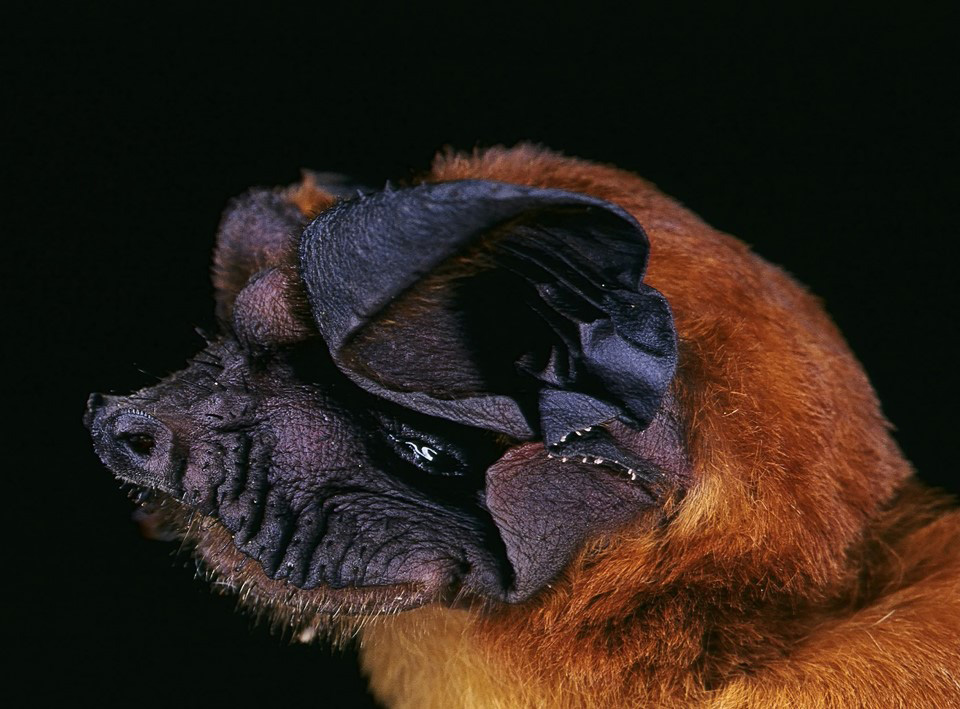
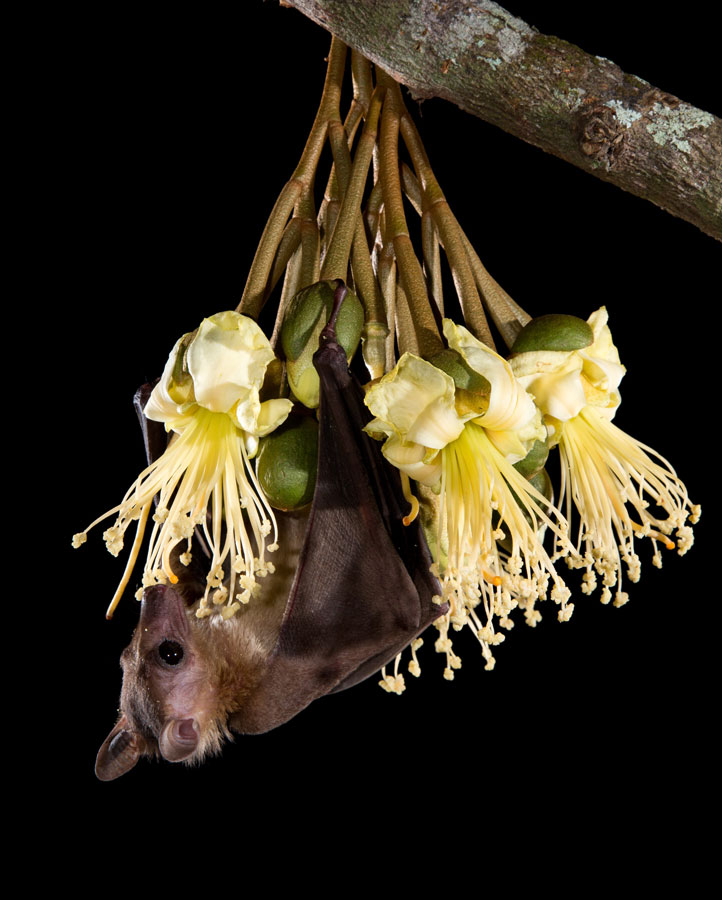
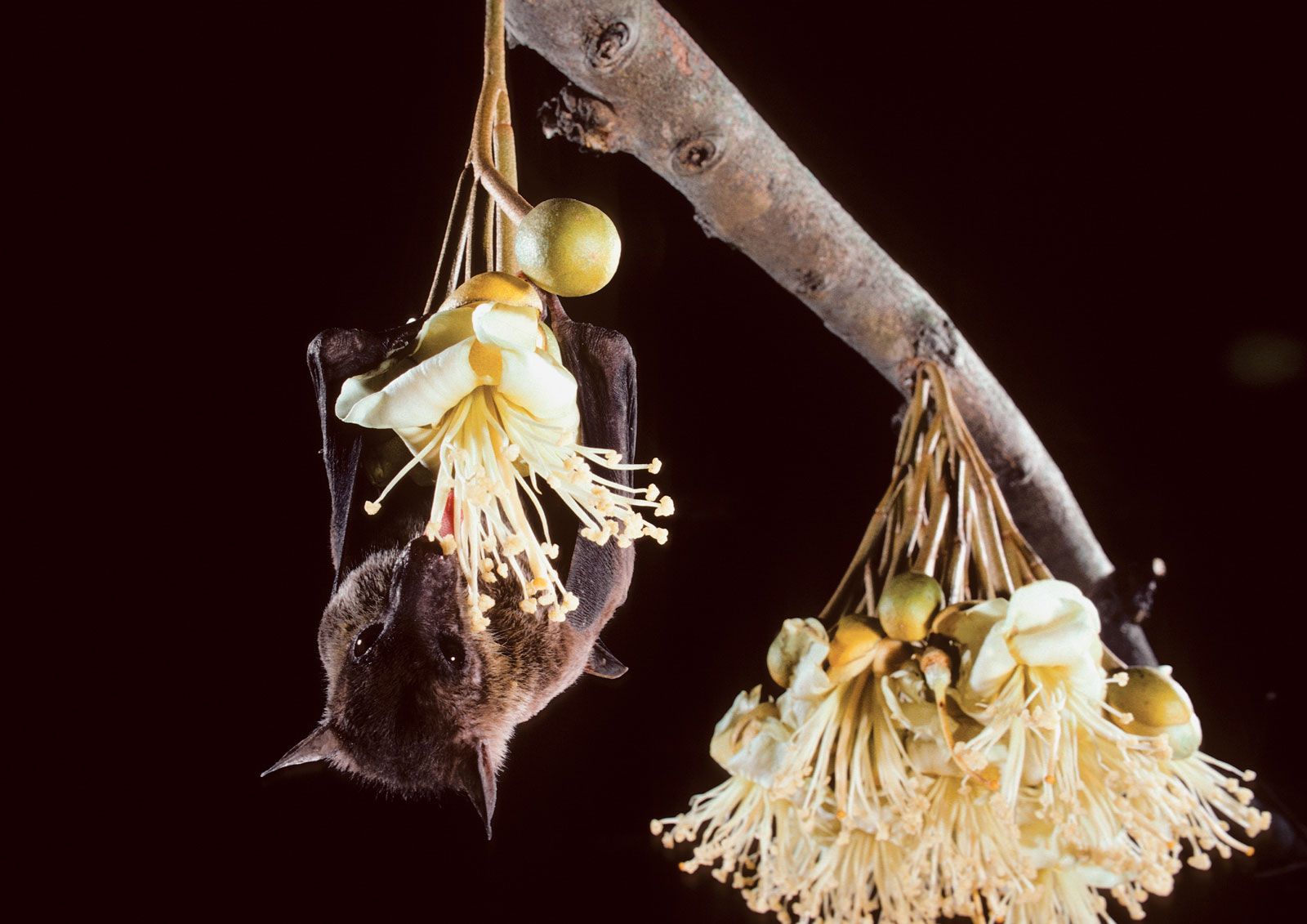
As mentioned, loss of habitat is just one challenge facing Southeast Asia’s bats. About half the region’s bats roost in caves, but these are not the peaceful refuges they once were. Tourism, harvesting of guano and cave swiftlet nests, people just hanging out– all can disturb bats at roosts.
Many of the cave systems in Southeast Asia are made up of limestone and quarried by the cement industry resulting in total loss of cave roosts. Intense hunting of some species, particularly the large fruit bats, or “flying foxes”, for consumption or a perceived medicinal use is pushing many species to the brink of extinction.
Demand for large fruit bats is so great in Indonesia’s North Sulawesi that populations have been wiped out in the north and bats are being hunted and shipped from other provinces of Sulawesi and nearby islands to meet demand– as many as 500 tonnes per year. Fifty years ago, similar hunting levels on the Pacific island of Guam drove the island’s flying fox species, found nowhere else in the world, to extinction and decimated populations of another nine species from nearby islands.
The reason that hunting has such a big impact is because bats are very like us in many ways. They are long-lived mammals, particularly for their size, with some species living more than 30 years. Most species only give birth to one pup a year, and large species like the flying foxes typically don’t start to breed until their second or even third year. This means that populations are very slow to recover losses and can’t withstand sustained disturbance or intense hunting.
Land-use change, widespread hunting and destruction of roosts threaten 24% of Southeast Asia’s species but the conservation status and population trends for many species are unknown. This is tragic because Southeast Asia is such an extraordinary region for bats – a bat diversity hotspot home to over 400 species. That’s about 28% of all the world’s 1400 bat species in just 11 countries!
For a long time, very little was known about the region’s bat diversity, with just a handful of dedicated researchers active, but over the last 10-15 years more researchers are training in bats and have come together to form a multinational network – the Southeast Asian Bat Conservation Research Unit (SEABCRU) – to exchange information and work together across borders.
There have been lots of exciting discoveries as a result, including the description of 40 species new to science in just the last 12 years – a rate of discovery that suggests that there are lots more species still to describe. How tragic it would be to lose species because of habitat loss before we have even found and described them.
Researchers in the SEABCRU have shown just how important bats are for humans, particularly for ecosystem health and human food security. Bats are important pollinators and seed dispersers of hundreds of ecologically and economically important plants. Most famously they are the key pollinator of the King of Fruits itself, durian. Durian is an $18 billion dollar industry, but no bats means no durian!
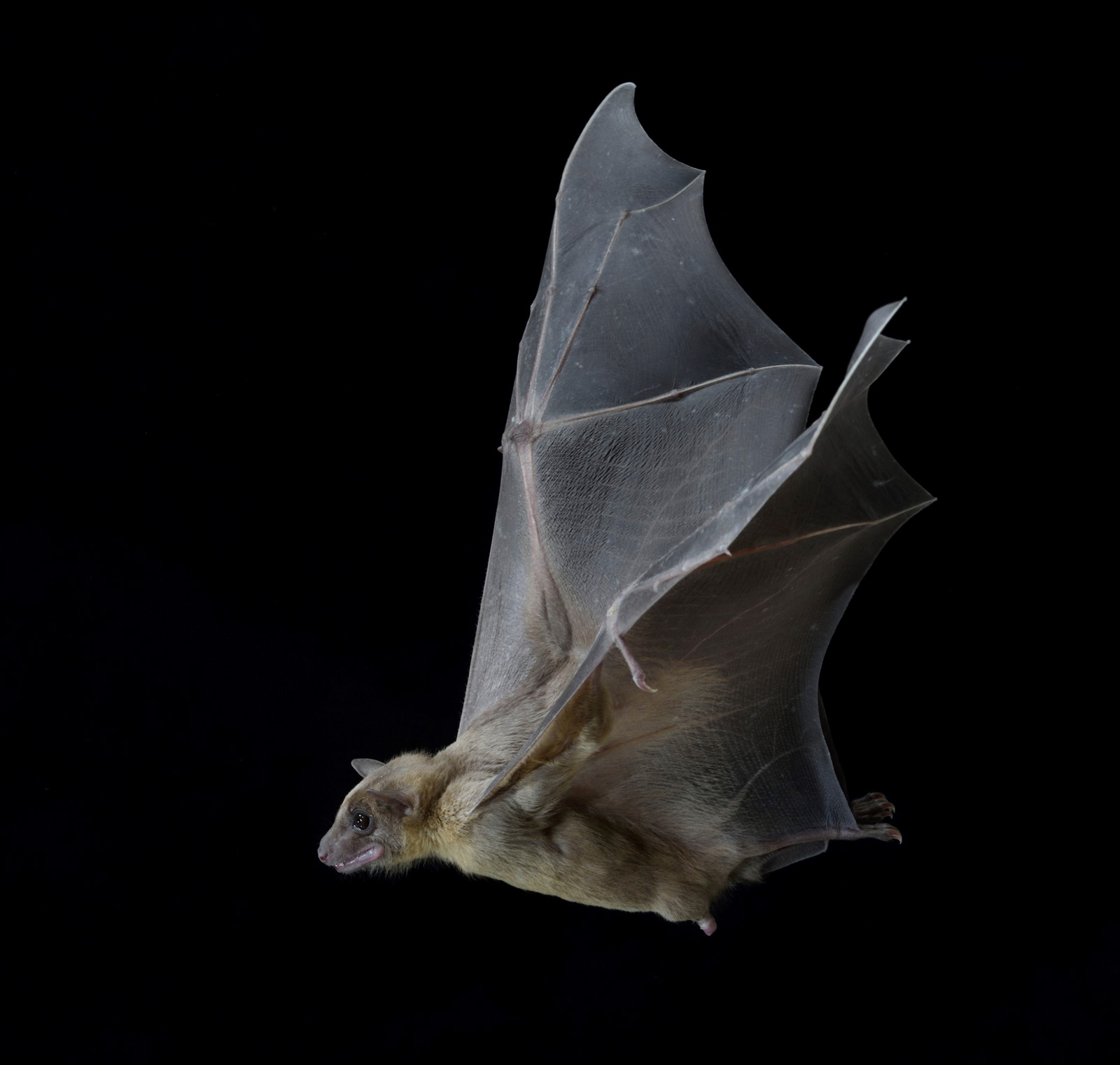
Dr Sara Bumrungsi and his students at Prince of Songkla University in Thailand have calculated that in southern Thailand alone, the services of just one species, the dawn cave bat, in pollinating durian and petai (another regional favourite) is worth around USD $12 million a year.
As their name suggests, cave dawn bats roost in colonies of thousands to tens of thousands in caves, but there are disturbing reports that numbers across Southeast Asia are declining as caves are lost to disturbance and limestone extraction, and populations hunted.
The wrinkle-lipped free-tailed bat is another colonial species that roosts in caves in the thousands and even millions. Each night, thousands of bats stream out of their caves and zoom out across the landscape, travelling tens of kilometres on some nights in pursuit of insects. Among their favorite foods are plant-hoppers – one of the biggest pests of rice crops in Southeast Asia.
One colony in Thailand of 2.6 million bats eats about four tonnes of these pests in a single night, and across Thailand this one species saves the country about 2892 tonnes of rice annually – that’s 26,000 rice meals! Of course, everything that bats are doing that benefits us, they also do in the forests and natural landscapes of the region, ensuring that bat-dependent trees are pollinated, seeds are dispersed, and insect populations suppressed.
It’s 11pm and Julie, Ain and I have just finished processing our 30 bats. Each bat was identified to species, sexed, and the length of its forearm and body mass recorded. We put numbered bands on their forearms so we can recognise individuals if we catch them again in coming years and learn how long they live, and how they move around the forest.
Ain found that most of the females were either pregnant or lactating – we are in the breeding season. The trefoil horseshoe bat did a so-so job on Julie’s flight obstacle course (a series of vertical strings), but the woolly bats skipped through as though there was nothing there. We take each bat back to the trap it was caught in for release.
This is one of the best parts of the night, so we share the bats out evenly, although, as the boss, I always get the trefoil horseshoe bats. I gently put my hand at the edge of the trefoil’s bag and open it up. After a bit of scrabbling, his feet latch onto my finger and I draw him out.
He hangs from my finger and scans the area with echolocation calls too high for us to hear. He’s not blind but lives in a world made of echoes. Satisfied, he silently launches from my finger and flies into the night.
